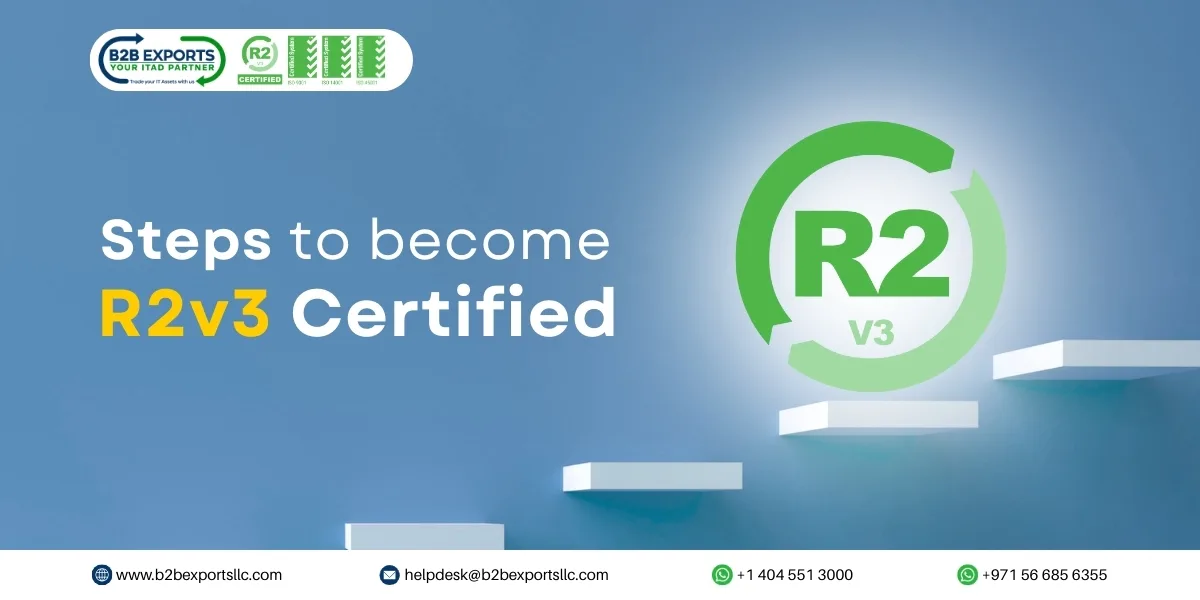The Role of R2v3 Certification in ITAD

All organizations widely use IT assets such as laptops, desktops and other essential IT equipment in their day-to-day operational tasks. As technology keeps advancing, organizations update their IT systems. It is important to carefully update IT systems while keeping confidential data safe. This is where ITAD comes in. IT Asset Disposition helps responsibly dispose of obsolete IT assets with certified methods while maintaining complete data security and compliance with necessary standards.
To minimize several risks of data breaches and financial penalties, organizations must partner with an IT Asset Disposition Services Company that is R2v3 certified and follows necessary regulatory standards. The R2v3 certification, developed by Sustainable Electronics Recycling International (SERI), sets standards for responsible IT Asset Management and e-waste recycling. This ensures that end-of-life IT assets are securely processed in an environmentally responsible way.
R2v3 stands for Responsible Recycling Version 3, the latest version of Responsible Recycling (R2) standard, focuses on ensuring proper data destruction, worker health safety and environmental responsibility. This certification ensures that every step in the disposition process is followed properly and meets strict international standards for data security. Organizations should partner with an R2v3 certified ITAD company to ensure trusted and certified services, protecting confidential data while staying compliant with globally recognized standards.
Understanding R2v3 Certification:
R2v3 certification is the latest version of Responsible Recycling (R2) standard which defines standards for data security and environmental protection. It is developed by Sustainable Electronics Recycling International (SERI), a non-profit organization dedicated to promoting sustainable management of electronics throughout their lifecycle. R2v3 is a globally recognized certification which defines how organizations should handle end-of-life IT assets responsibly. It focuses on maximizing the life of IT assets while ensuring safe recycling.
R2v3 certifications provide a framework for safely using IT equipment and correctly recycling it. It helps organizations follow data security, environmental protection and worker health safety practices. Along with these core requirements, R2v3 certification also applies to process requirements to only specific activities like data destruction and reuse. R2v3 certification allows companies to build one size fit certification that fits all their operations.
R2v3 certifications also support a chain of custody to every component throughout the disposition process, reducing risks of asset and data loss. It shows a strong alignment with globally recognized standards such as ISO 9001, ISO 14001 and ISO 45001. By earning R2v3 certification, organizations show their commitment to secure data handling, environmental sustainability and recycling practices, establishing themselves as a reputed organization in the industry.
Core Principles about R2v3 Certification:

R2v3 certification is based on key principles which ensure responsible management of used IT assets to protect both the data and environment. It tells organizations the correct way to handle unused IT assets using recycling practices and preventing them from going into waste, minimizing environmental effects and promoting environmental sustainability. For the disposition of unused IT assets, it uses recycling practices that responsibly dispose of retired IT assets while protecting sensitive data and maintaining compliance with essential standards.
R2v3 certification focuses on reuse and recycling, extracting the highest possible value from retired assets before completely discarding them. This helps in maximizing asset utilization and empowering the circular economy. This certification also provides a strong area to data security, ensuring critical data is handled with care and the risks of data are reduced. Further, this helps in operating smoothly without any risk of data breaches.
Environmental health protection is also an important part emphasized by R2v3 certification which helps to minimize environmental effects, reduce e-waste and add valuable contributions to environmental sustainability. Along with this, it focuses on worker health safety, protecting workers and nearby communities. Together, these principles establish R2v3 certification as a globally recognized standard for responsible recycling and handling outdated IT assets with care.
Key Updates Introduced in R2v3 Certification:
The R2v3 certification, developed by Sustainable Electronics Recycling International, updates the previous R2:2013 standard to the latest R2v3 certification to make it a more flexible and sustainable framework for electronics recycling. Key updates in the R2v3 certification are:
1. Flexible Design:
R2v3 certification comes with a more flexible design, allowing facilities to certify specific processes they perform, such as data sanitization, recycling and destruction. This makes the certification more flexible and adaptable to different operations.
2. Key and Process Specifications:
The process has now been separated from core requirements, which applies to all processes and key requirements, which applies to only specific processes, improving clarity and focus.
3. Enhanced Data Security:
R2v3 provides a strong area to data security by setting strict rules for data handling, caring and tracking to reduce the risks of data breaches, maximizing data security and keeping confidential data safe.
4. Expanded Environmental, Health and Safety (EHS) Controls:
R2v3 certification adds clearer and stricter rules to manage environmental health protection and worker health safety. It emphasizes strong rules to responsibly handle hazardous material through responsible recycling.
5. Reuse first, Recycle Later:
This standard prioritizes asset reuse using professional refurbishment, repair and resale through IT asset remarketing. If these devices are not repurposed, then they are responsibly recycled using ecofriendly practices.
6. Improved Transparency and Traceability:
This standard helps improve transparency by providing proper documentation of each step in the disposition process and helps trace assets to avoid risks of asset loss.
R2v3 vs R2:2013 - What has changed?

R2v3 has brought a comprehensive change in the structure for responsible electronics recycling compared to R2:2013. While the previous version focused on health, safety and environmental controls, the current version focuses on important aspects like data security, maximum reuse and minimum risk. It focuses on all important areas, from data security and health safety to risk management and environmental protection.
One of the biggest changes that R2v3 has made is the implementation of different rules for each facility used in the industry. In the 2013 version, there was a common rule for all facilities regardless of the practice they use. The current version allows separate sections for specific work a facility does like data wiping, refurbishment or e-waste recycling. This helps make the audit more accurate.
R2v3 has also strengthened the data security area, in the previous version, the major focus was on health, safety and environment protection only. R2v3 provides a strong area for data security, minimizing data breaches and securing confidential data. This helps make IT Asset Disposition even safer by protecting important data, handling e-waste responsibly and adding valuable contributions to the environment.
Additionally, R2v3 encourages reuse of outdated devices by professionally refurbishing them and turning them into usable assets. This not only increases the asset utilizations but also contributes to the IT economy. Overall, R2v3 certification makes the disposition even more transparent and safe, aligned with modern environmental sustainability.
Why is R2v3 Certification critical for the ITAD industry?

1. Enhanced Data Security Measures:
R2v3 certification strengthens data security by keeping the confidential data safe and reducing data breaches risks. The R2v3 certification imposes strict rules to handle sensitive data responsibly, which ensures complete data security of the client’s devices and assures them that their data is handled responsibly.
2. Improved Transparency:
R2v3 certification helps improve transparency by providing necessary certifications and documentation including certificates of data destruction which helps increase clients' trust. This allows companies to show exactly the services they are certified for, like data sanitization, destruction or disposition, helping clients to easily find companies for their needs.
3. Environmental Sustainability:
R2v3 certification adds valuable contributions to the environment by responsibly handling e-waste and using ecofriendly recycling practices. It encourages ITAD companies to utilize the asset to its full potential and repurpose it instead of direct destruction. All harmful materials are carefully recycled, which helps in reducing electronic waste and promoting environmental sustainability.
4. Better Operational Accountability:
R2v3 certification helps improve operational accountability by providing strict rules and regulations to handle the IT assets responsibly. Due to the strict rules, ITAD companies need to show their work process, quality standards and risk management. This ensures that companies use certified ITAD practices and handle IT assets responsibly.
5. Proper Risk Management:
When ITAD companies adhere to R2v3 certification, they just don’t use certified disposition practices but also help them identify and mitigate potential risk at every stage of IT asset lifecycle. When companies use certified ITAD practices, they follow strict data destruction rules and maintain compliance for safe IT asset disposal, which helps them stay safe from legal risks.
6. Meeting Global Compliance:
Many organizations choose ITAD partners who are R2v3 certified and meet essential standards for e-waste handling and data management. R2v3 certification provides strict rules to manage confidential data, it is a global accepted framework for managing highly sensitive and extremely important data. By following R2v3 standards, ITAD companies minimize several legal risks.
How does R2v3 strengthen Data Security in ITAD?
Data security is the most important factor for every IT Asset Disposition (ITAD) provider. R2v3 helps maximize data security in ITAD by providing strict data security rules. R2v3 is an important data security framework accepted all around the world and demonstrates that ITAD providers are using correct disposal methods. There are heavy fines and legal penalties for not following R2v3 standards, due to this all ITAD providers strictly follow essential standards which results in maximum data security.
R2v3 focuses primarily on data sanitization to securely wipe out the sensitive data from the assets, reducing risks of data breaches and keeping the important data confidential. Data sanitization is a critical step in the data destruction process. This includes various methods to erase data such as secure data wiping, degaussing and destruction. Data is deleted in such a way that it cannot be recovered even with advanced data recovery tools. Under R2v3, ITAD companies must keep clear and traceable audit logs of every asset, ensuring accountability at every step.
R2v3 helps maximize data security through risk assessment where all the vulnerabilities in data handling are identified and fixed. It maintains a strict chain of custody which helps in preventing unauthorized access and keeps all assets managed. The complete data destruction process is carried out under specialized professionals using certified methods at each step. R2v3 certified ITAD providers also provide complete documentation along with data destruction certificates to ensure certified asset disposal and complete peace of mind to clients.
Environmental Impact of R2v3 Certification:
R2v3 certification plays a crucial role in minimizing environmental effects by guiding ITAD companies towards safe and environmentally friendly ITAD practices minimizing environmental waste. It provides a structured framework for the correct disposal of IT assets, ensuring harmful materials are responsibly processed without affecting the environment.
The R2v3 standard suggests reuse before recycling, encouraging ITAD providers to maximize asset utilization by repurposing the functional assets and remarketing them through IT Asset Remarketing practices, helping organizations recover maximum potential value from the outdated assets. This not only helps in maximizing asset utilization but also helps organizations unlock residual value while reducing environmental affect and promoting environmental sustainability.
R2v3 helps promote environmental sustainability through Responsible Downstream Management, ensuring complete disposition process maintain compliance with essential standards. It also prohibits illegal export of harmful e-waste to other countries, minimizing e-waste. Additionally, it helps in managing e-waste safely and contributes to a circular economy by maximizing reuse instead of direct destruction, preventing assets from going into the landfills.
Steps to become R2v3 Certified
Organizations look for ITAD partners who are R2v3 certified and maintain compliance with other globally recognized standards. Here are the following steps that ITAD companies generally follow:
1. Understand the R2v3 Certification:
Organizations should start with understanding the R2v3 certification. They should study all the core requirements and applicable processes to identify which sections apply to their requirements.
2. Conduct a gap analysis:
Current practices are carefully checked by internals and consultants to identify the areas of improvement. This helps organizations stay updated and use practices that comply with essential standards.
3. Implement Required Processes:
This step includes the establishment of various processes used in data sanitization, like data wiping, destruction and degaussing. It also maintains a chain of custody controls and vendor management systems.
4. Develop Documentation:
Organizations should develop documentation at each step in the process. The essential documentation includes policies, SOPs, Data Destruction certificates, training records and asset tracking logs.
5. Internal Audit & Management Review:
Companies must conduct regular audits to check all the processes that comply with R2v3 standards and other essential international certifications to keep the process free from legal risks.
6. Third Party Certification Audit:
A certified R2 auditor reviews the facility and if everything meets the standards, they provide the R2v3 certification.
R2v3 Certification and The Future of ITAD Industry:
The ITAD industry is rapidly growing, and so is the concern for growing e-waste. With the increasing corporate needs and sustainability demands, the ITAD industry will continue to grow driven by strict data privacy and environmental protection laws. R2v3 certification is driving the industry by promoting higher standards in data security, maintaining transparency and contributing to environmental sustainability.
One of the most significant impacts of R2v3 certification is its alignment with recognized standards for data security and environmental protection. Organizations now a days search for ITAD partners who can ensure secure data destruction, responsible recycling and proper IT asset management. R2v3 certification helps organizations easily find certified ITAD partners.
R2v3 will help ITAD have a strong and positive future by contributing to circular economy practices where reusing and refurbishing will become the primary focus along with data security. There will be advanced tracking systems like a digital chain of custody systems for complete transparency at each step in the process. It will make strict rules like mandating R2v3 certification for every ITAD partner, reducing e-waste and promoting environmental sustainability. In the long run, R2v3 certification will not just be a compliance requirement, it will become a competitive advantage.






